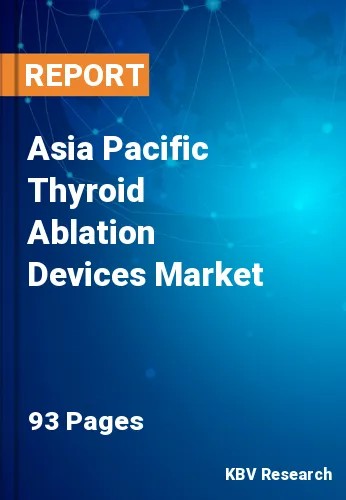The Asia Pacific Thyroid Ablation Devices Market would witness market growth of 13.5% CAGR during the forecast period (2022-2028).
An endocrine surgeon uses the minimally invasive radiofrequency ablation (RFA) procedure under the supervision of ultrasound imaging. As the body processes the ablated tissue, the doctor uses targeted radio waves to disrupt the nodule's cells, forcing them to contract. Additionally, RFA helps patients quickly return to their regular daily activities. While the portion of the thyroid may be removed during surgery, RFA preserves thyroid integrity, supporting enhanced thyroid function.
Microwave ablation (MWA) has most recently been suggested as a treatment for thyroid nodules based on its use in other organs, particularly the liver, kidney, and lung. Furthermore, laser ablation therapy is a relatively recent non-surgical treatment option for benign thyroid nodules. The technique has been applied in the past to treat thyroid cysts and remove lymph nodes affected by thyroid cancer. Therefore, treatment for thyroid nodules using laser ablation therapy (LAT) is very much an outpatient treatment. Additionally, the innovative ablation procedure known as high-intensity focused ultrasound (HIFU) can effectively decrease thyroid nodules and relieve pressure-related symptoms.
The High-Income part of the Asia Pacific region experienced the greatest DALY rate for thyroid cancer in 2019 as well as the highest thyroid cancer-related mortality rates. Compared to other Asian regions, this region experienced substantially higher growth in DALYs. The rates of incidence, prevalence, mortality, and DALY of thyroid cancer in women were significantly higher than those in men throughout all of Asia and in the High-Income Asia Pacific region. Men aged 80–89 years had a greater DALY rate than women among Asian thyroid cancer patients. Age-related increases in the DALY rate were slow, and age-related declines in thyroid cancer patient death were observed in the region. The age group from 40 to 79 years old had the highest frequency. Consequently, the demand for ablation devices is high in this region, which is beneficial for the market.
The China market dominated the Asia Pacific Thyroid Ablation Devices Market by Country in 2021, and would continue to be a dominant market till 2028; thereby, achieving a market value of $22,799.6 Thousands by 2028. The Japan market is estimated to grow a CAGR of 12.8% during (2022 - 2028). Additionally, The India market would experience a CAGR of 14.2% during (2022 - 2028).
Based on End-use, the market is segmented into Hospitals, Ambulatory Surgical Centers (ASCs), Cancer Specialty Centers and Others. Based on Type, the market is segmented into Radiofrequency Ablation, Microwave Ablation and Others. Based on Application, the market is segmented into Thyroid Cancer and Thyroid Nodules. Based on Product, the market is segmented into Thermal-based Devices and Non-thermal-based Devices. Based on countries, the market is segmented into China, Japan, India, South Korea, Singapore, Malaysia, and Rest of Asia Pacific.
Free Valuable Insights: The Worldwide Thyroid Ablation Devices Market is Projected to reach USD 289.9 Million by 2028, at a CAGR of 13%
The market research report covers the analysis of key stake holders of the market. Key companies profiled in the report include Medtronic PLC, Boston Scientific Corporation, Integra LifeSciences Holdings Corporation, Johnson & Johnson, Theraclion SA, Olympus Corporation, Terumo Corporation, BVM Medical Limited, MedWaves, Inc., and STARmed Co. Ltd.
By End-use
By Type
By Application
By Product
By Country
Our team of dedicated experts can provide you with attractive expansion opportunities for your business.

